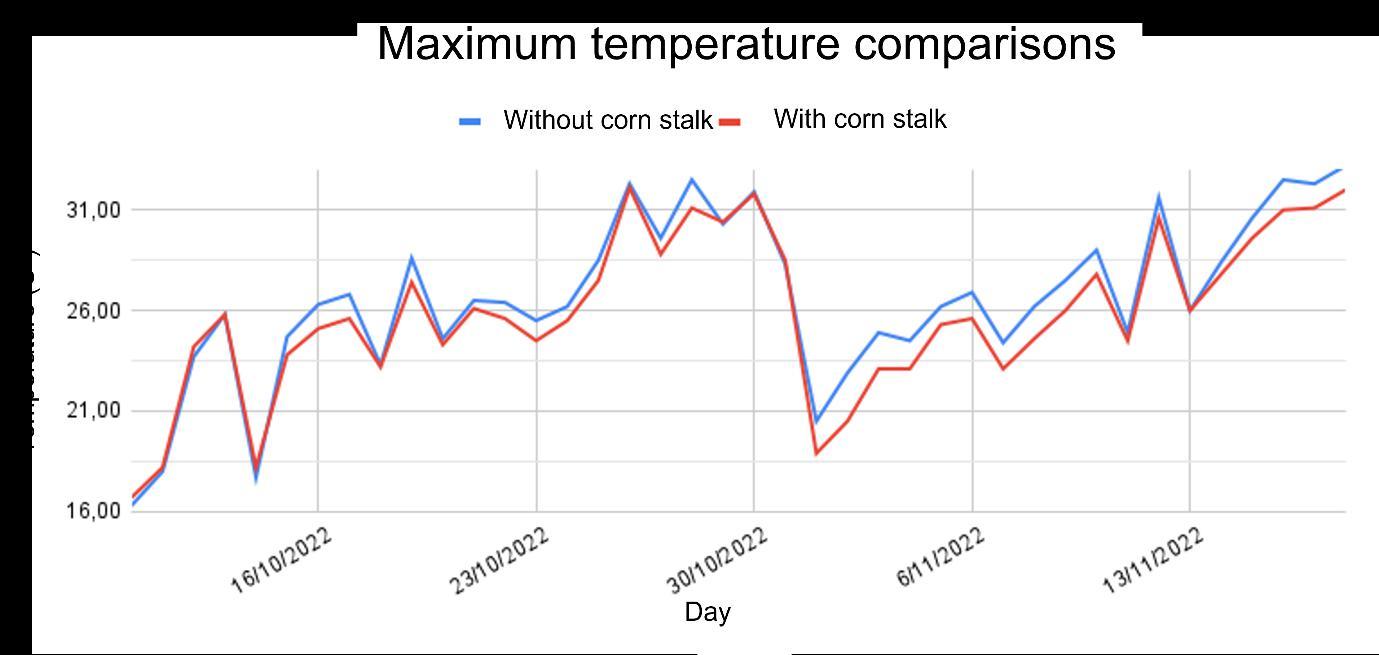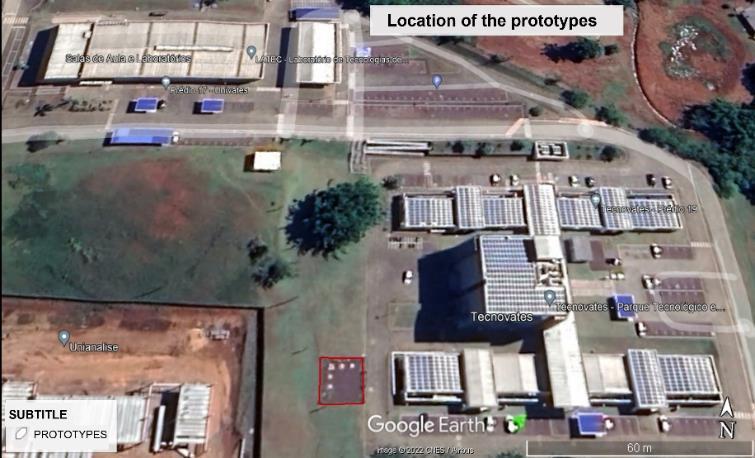
10 minute read
Analysis of the thermal behavior of Masonry Concrete Block with Internal Natural Element Coating
from Analysis of the thermal behavior of Masonry Concrete Block with Internal Natural Element Coating
Luiza Malvessi Lagemann1 , Henrique Laste da Silva2 , Luciana Turatti3 , Rodrigo Spinelli4
1Architecture Student
Advertisement
2Civil Engineering
3Lawyer, PhD in Law. Professor of the Graduate Program in Sustainable Environmental Systems – PPGSAS, University of Vale do Taquari – UNIVATES
4Architect, PhD in Environmental Sciences. Professor of the Graduate Program in Sustainable Environmental Systems - PPGSAS, University of Vale do Taquari – UNIVATES
Received: 01 Mar 2023,
Receive in revised form: 19 Mar 2023,
Accepted: 02 May 2023,
Available online: 09 May 2023
©2023 The Author(s). Published by AI
Publication. This is an open-access article under the CC BY license (https://creativecommons.org/licenses/by/4.0/).
Keywords Structural concrete block. Corn stalk. Thermal insulation. Energy efficiency.
Abstract The search for constructive forms that are less aggressive to the environment has become increasingly relevant, in view of the scarcity of natural resources and population growth. With the current energy and environmental scenario in the world, it is possible to say that the situation is delicate, given the demand for energy by the population and the dependence on exhaustible natural resources and polluting the environment for it to be produced. This exacerbated use of energy can be related to the generation of artificial air conditioning for the thermal comfort of the inhabitants. In order to mitigate energy consumption inside buildings, this study aims to analyze the internal temperature of the environment after inserting the corn stalk inside the empty spaces of the concrete block used for conventional masonry. To verify the thermal performance of the concrete block filled with corn stalks, 5 prototypes were built with different constituent materials, and the internal temperatures were recorded using datalogger devices. The temperature analyzes took place in the spring, in the months of October and November, totaling 39 days of data collection, and through these data, it was possible to identify that yes, the junction of the manually molded concrete block and the filling of the corn stalk showed an improvement in the internal thermal performance in the prototypes built with this material.
I. INTRODUCTION
Problems with energy crises have always been present in our society. Different episodes make society reflect on attitudes towards rationing and saving electricity on a day-to-day basis. As Spinelli et al. (2013) explain, faced with the triggering of energy crises in the early 1970s, it was possible to reflect on the need to transform the reality of Brazilian construction methods, reducing energy consumption and mitigating the waste of non-renewable natural resources.
The threats of blackout in the electricity sector during 2001 and the rationalization imposed on Brazilian society were the milestone for the enactment of Law No. 10,295, dated 17 October 2001, which established the National Policy for the Conservation and Rational Use of Energy, encouraging studies and research related to energy efficiency, aiming at greater energy efficiency in buildings (CARLO, 2008).
The basic objective of a building is sheltering the user, providing a comfortable internal environment in its acoustic, thermal and air quality variations, mitigating possible severe climates and providing comfortable environments in relation to the external environment of the building in mild climate situations (MORONI, 2015).
Along with the intention of achieving greater energy efficiency in buildings, Prudêncio Jr. et al. (2002) comments that Brazil is experiencing a moment of technical renewal, unified with the introduction of construction methods that can offer greater productivity, cost reduction, better management at the construction site and greater freedom for the designer in the implementation of projects. With that, many Brazilian companies started using concrete blocks in structural and conventional masonry in Brazil, providing a greater range of options for designers and builders.
As Mohamad (2015) shows, the economy in this construction method is a differential, and can be achieved through optimization of tasks at the construction site, use of simplified executive techniques, and ease of control in production stages. Thus, considering the aforementioned aspects, there is mitigation in the waste of materials produced by rework.
The use of concrete blocks in buildings ends up significantlyinfluencingtheinternalthermalcomfortforthe user, since the concrete block has lower thermal resistance approximately three times lower compared to the ceramic block. According to ABNT 15220 (NBR, 2005), thermal conductivity ( ��) of the concrete block is 1.75 W/m.k, and that of ceramic blocks varies between 0.70 and 1.05 W/m.k.
In this way, unifying the use of concrete block and corn stalk, this paper seeks to evaluate a new use for residues from the cereal industry that produces corn, considering that the stalk of the corn plant can have a significant potential for mitigating the heat that enters structures built with concrete blocks, providing a new alternative for when a better thermal performance in the environment is needed. Thus, the analysis in this paper aims to verify a possible thermal potential in the corn stalk when inserted in the external cavities of concrete blocks.
II. METHOD
The research methodology was experimental, which, according to Filho et. al. (2015), consists of determining an object of study with a selection of different variables capable of influencing and defining the forms of control and observation of the effects that each variable produces on the object.
2.1 Location of the Study
The prototypes used for the experiment are located next to building 20 and close to LATEC (Laboratory of Construction Technology), which is located in building 17, at Universidade do Vale do Taquari – UNIVATES, in the city of Lajeado/RS, as can be seen in Figure 1. The site coordinates are: latitude 29º26’56.22”S; 51º56’40.61”W; altitude of 41 m.
2.2 Collection and Selection of the Natural Element
For this natural element to be used, it was necessary to collect it from a few rural properties that plant corn. The corn harvest period starts in November and continues until March. The corn stalk is obtained when the plant is already dry, after corn harvesting
Following the harvest, it is necessary to clean the stalks for later use In the cleaning process, the stem is peeled, thus yielding a soft material, similar to polystyrene, as can be seen in Figure 3.
2.3 Block Molding
Molding of the concrete blocks was artisanal, from the proposal developed by Rosa (2017), who created this block design in her course completion work at Universidade do Vale do Taquari – UNIVATES. The block has a total area of 0.0026 m² and its dimensions are shown in Figure 4.
A metallic manual mold was used for molding the blocks, whereby the entire molding process is conducted manually. Initially, 64 blocks were molded, with 32 units for each prototype. There were several molding attempts until the ratio was found so that the blocks would remain standing after unmolding.
These were the materials used for block molding: CP-IV 32 cement, regular sand, gravel powder, and water. Through consultations in manually molded block materials, the ratio of 1:3:3 was adopted respectively, with a content of 0.75 w/c. It can be considered a ratio rich in cement. The w/c content was set through trial and error during the molding process.
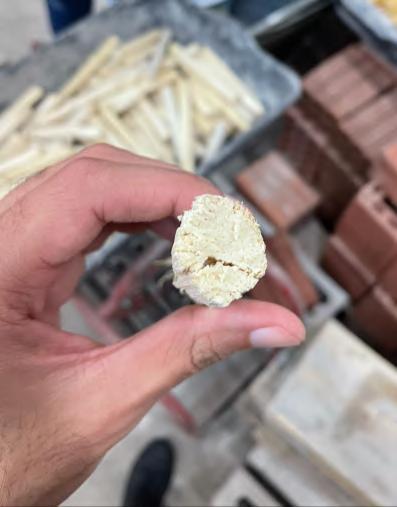

Throughout the process, the blocks proved to be fragile and brittle after molding, when the utmost care was always required in handling them. As moldings evolved, the blocks became better, more resistant and homogeneous. A possible cause for block fragility was the lack of homogeneity in the molding mortar.

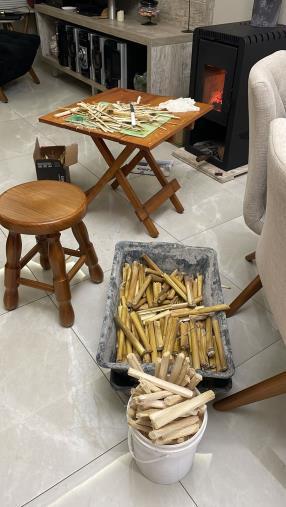
After molding, the blocks settled for 7 days so that they could be moved from the floor where they had been placed. After these 7 days, they cured for another 7 days in a dry and airy place. It is possible to see all the stages of block molding in Figure 2.

2.4 Prototype Building
In analyzing the thermal insulation potential of the concrete block filled with corn stalks, five prototypes were built with different materials. Of these, three prototypes were built from materials with the highest frequency of commercialization and construction in the study region: solid ceramic brick, nine-hole ceramic block and conventional concrete block. The other two prototypes were molded with amanual mold for concreteblocks designed by student Laura da Rosa, in 2017, as can be seen in Figure 3.
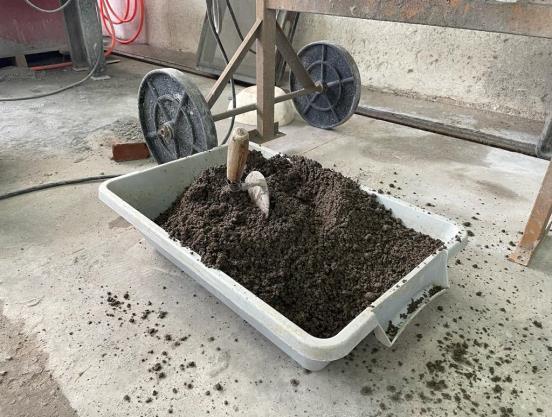


Continuing with the methodology, prototype building began. Construction phases can be seen in Figure 4.
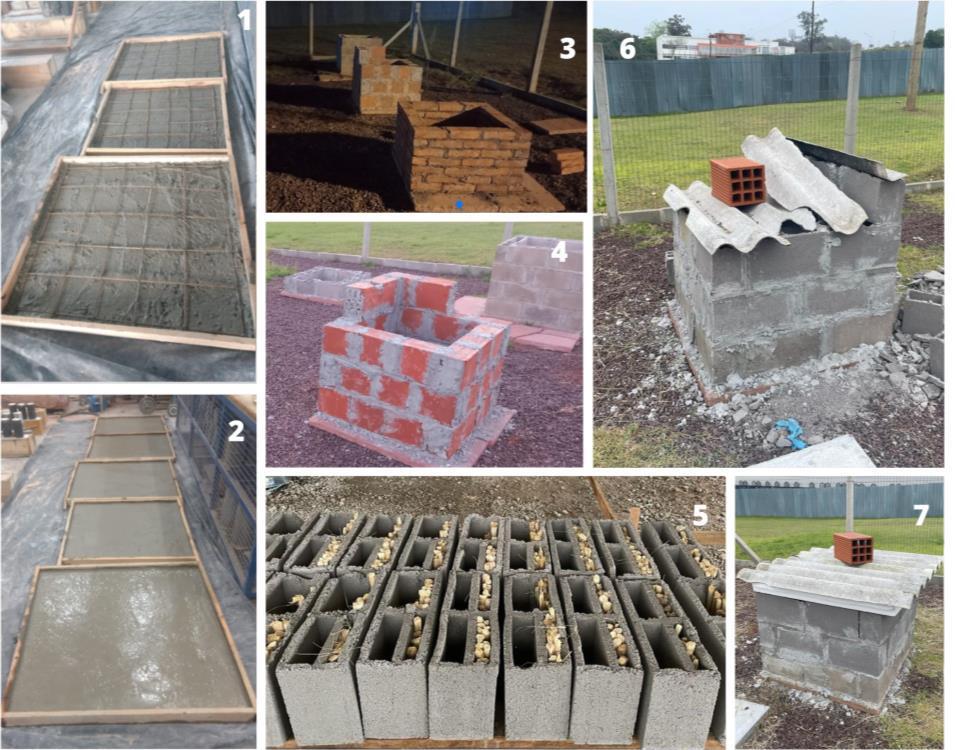

Prototype 1 (solid ceramic block): Built with solid ceramic blocks measuring 24 cm x 11.5 cm x 5.3 cm, based on a stoneware slab, set in mortar with conventional ratio, 1.5 cm thick, resulting in a prototype with dimensions of 0.85 x 0.85 m, as seen in Figure 5 (1).
Prototype 2 (nine-hole ceramic block): Built with nine-hole ceramic blocks measuring 24x14x19 cm, based on a stoneware slab, set in mortar with conventional ratio, 1.5 cm thick, resulting in a prototype with dimensions of 1.09 x 1.09 m, as seen in Figure 5 (2).
Prototype 3 (conventional concrete block): Built with conventionalconcrete blocks measuring39x14x19 cm, based on a stoneware slab, set in mortar with conventional ratio, 1.5 cm thick, resulting in a prototype with dimensions of 0.94 x 0.94 m, as seen in Figure 5 (3).
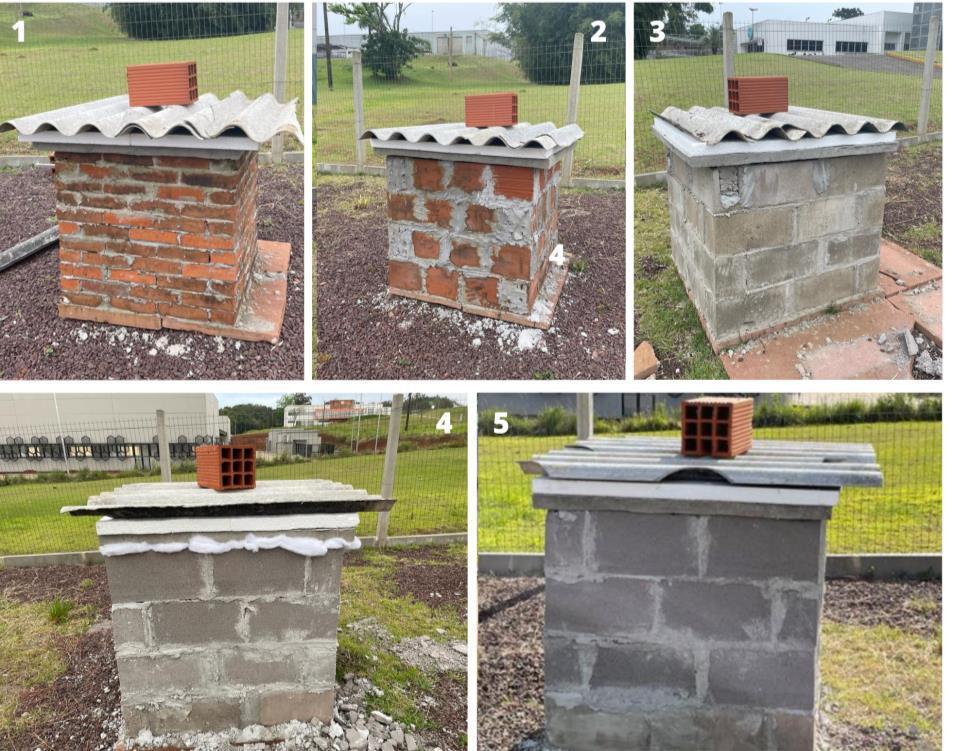
Prototype 4 (manual-mold concrete block): Built with concrete blocks molded from a manual mold measuring 39x14x22 cm, based on a stoneware slab, set in mortar with conventional ratio, 1.5 cm thick, resulting in a prototype with dimensions of 0.94 x 0.94 m, as seen in Figure 5 (4).
Prototype 5 (manual-mold concrete block with corn stalk filling): Built with concrete blocks molded from a manual mold measuring 39x14x22 cm, based on a stoneware slab, set inmortarwith conventionalratio,1.5 cm thick, resulting in a prototype with dimensions of 0.94 x 0.94 m, as seen in Figure 5 (5).
A cover was added to all prototypes, for better simulation of thermal performance, consisting of a solid, 50 mm thick concrete slab. Polystyrene sheets measuring 100x100 cm, 50 mm thick, were placed on the slab, and the prototypes were covered with 5 mm thick fiber cement tiles.
2.5 Data Collection
After prototype construction was completed, data collection for analysis began.
The capture of temperature measurements for analysistookplaceinthemonthsofOctoberandNovember, more precisely between 10 October 2022 and 18 November 2022, in the spring season, for 39 days, with a sampling rate of 15 minutes, as can be seen in Figure 8. This sampling rate was configured in the datalogger devices that were to measure internal temperatures.
In order for the devices to be placed inside the prototypes, all the cover slabs were perforated, so that hooks could be inserted for positioning the dataloggers.

The devices were positioned at a height of 50 cm above the ground, exactly at the center of each prototype, for possible mitigation of any external agents that could interfere with the analysis results, as can be seen in Figure 9.

III. RESULTS
Analyses results are based on temperatures collected by the datalogger devices that were inserted in the prototypes and the temperatures provided by the NIH (Hydrometeorological Information Center) of Univates. Maximum and minimum temperatures of the days of data collection were used in the analyses.
Graphs were developed for better visualization of possible thermal differences between the prototypes. The graphs make comparisons between the prototypes, considering temperature, as well as relative humidity of air in each one. As there were more than three thousand temperature captures for each prototype, a filter was created for the maximum and minimum temperatures of each day. It is possible toobserve,in Graph 1, theinternaltemperature differences within each prototype, when comparing all prototypes.
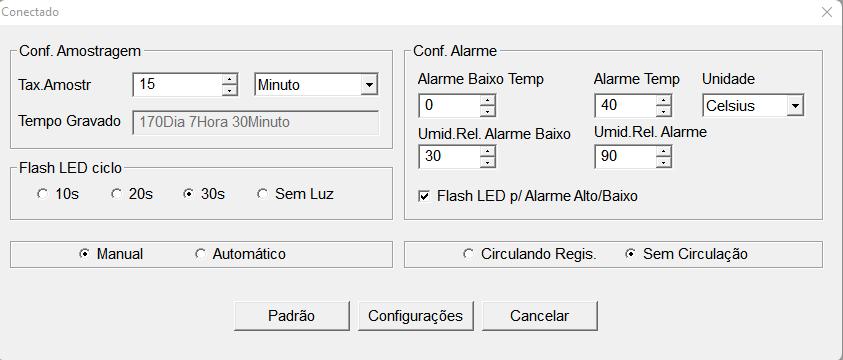
In Graph 1, it is possible to observe that the highest temperatures were found in the prototypes built with solid brick, conventional concrete, and manual-mold concrete block without the stalk. The two prototypes that displayed lower temperatures were those built with nine-hole ceramic block and manual-mold concrete block with stalk, demonstrating that the filled block provided better performance than all others.
Following the analyses, a comparison of the minimum temperatures was made, as can be seen in Graph 2.


As can be seen in Graph 2, all prototypes maintained approximate minimum temperatures; only on 01 November 2022 there were greater temperature differences. From graph data, it is notable that the prototype built with ninehole ceramic blocks showed higher temperatures within the minima, which means that this type of material does not easily lose the internal caloric energy of the block. On the other hand, the prototype built with conventional concrete blocks showed the greatest energy loss, cooling the environment more easily.
Still on Graph 2, it is interesting to analyze the external temperature in relation to internal temperatures found in the prototypes, where the minimum external temperatures presented an average of 15.12 ºC, while the average inside the prototypes was 17.89 ºC, thus demonstrating a thermal retention capacity of the materials used. According to the graph, the prototype that best presented temperature conservation was the one built with nine-hole ceramic blocks.
In Graph 3, it is initiated the series of comparisons between the maximum temperatures of the four prototypes solid brick, nine-hole ceramic block, conventional concrete block, and molded concrete block without stalk filling and the prototype with stalk filling. In this first case, the thermal behavior of the ceramic solid block was compared and among all the maximum temperatures captured for the prototypes, in all of them the prototype with corn stalk filling performed better. In an average among all maximum temperatures, the filled block presented maximum temperatures 5.22% lower than the solid ceramic block. With the “barriers” created to improve thermal performance in the prototype with filling, an improvement was expected, and it was demonstrated through this value of 5.22% noting that, in the molded block with stalk filling, there are air barriers and the natural insulator barrier.
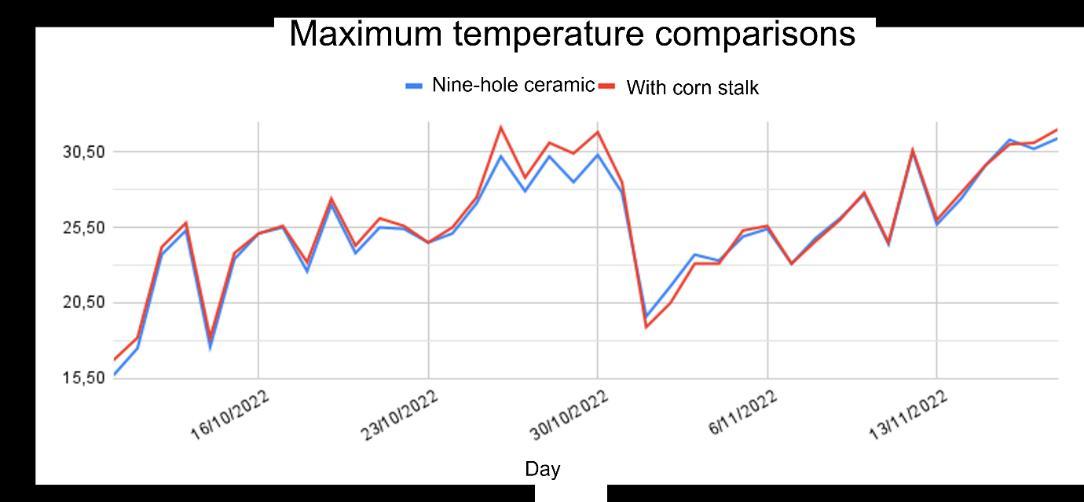
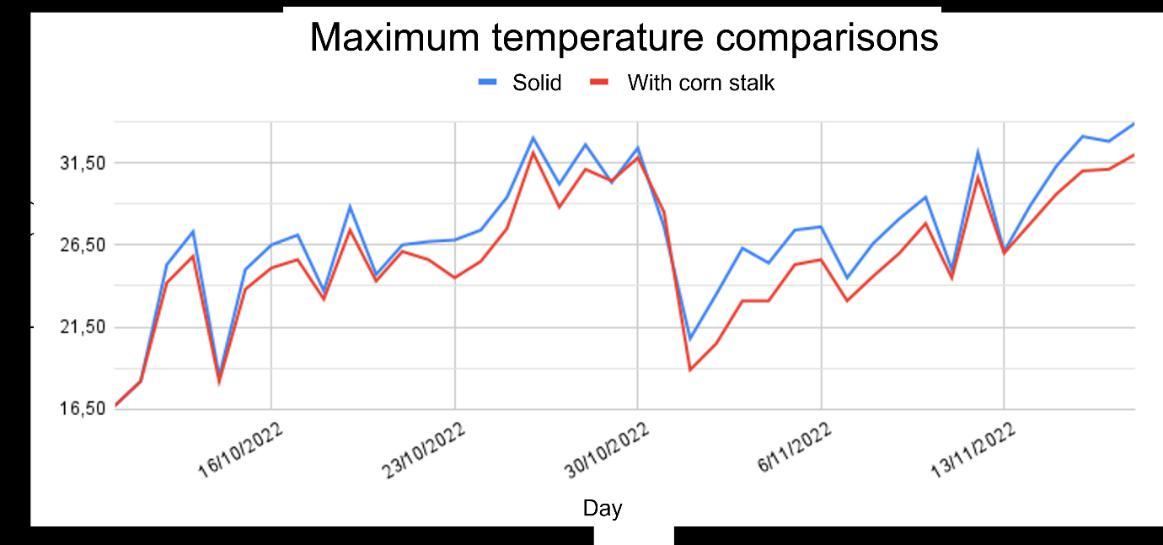
Source: From the Author (2022).
Analyzing Graph 4, which demonstrates the comparison of the maximum temperatures between the nine-hole ceramic block and the concrete block with filling, it is seen that the temperatures are close. However, in most of the captures, the nine-hole ceramic block displayed better thermal performance inside the prototype, with temperatures lower than 1.56% of the temperatures obtained in the filled concrete block.
Considering that the thermal conductivity (��) of concrete is 1.75 W/m.k and that of ceramics varies between 0.70 and 1.05 W/m.k according to ABNT 15220 (NBR, 2005), the concrete block with corn stalk filling showed values close to those displayed by the nine-hole ceramic block. Thus, the results were significant when comparing thermal conductivities between the materials.
Source: From the Author (2022).
Continuing with the graphic analysis of maximum temperatures, Graph 5 presents the comparison of the conventional concrete block and the filled concrete block. In this case, the analysis may have greater consideration for the characteristics of the materials used, where both are concrete blocks, differentiated by the natural element filling and the air cavity in the blocks.
In the case of Graph 5, the average maximum temperature of the conventional concrete block prototype was 27.77 ºC, 4.63% above the average presented by the filled block prototype, which was 26.54 ºC. In most of the temperature captures within the analysis, the coated block performed better than the conventional concrete block. Analyzing the graph, and considering all the daily maximums, in only 10.26% of the cases the conventional concrete block was able to match or surpass the filled concrete block.
Graph 5 – Maximum temperatures: Conventional concrete block and manually molded concrete block with corn stalk filling.

Source: From the Author (2022).
Graph 6 – Maximum temperatures: Manually molded concrete block without corn stalk filling and manually molded concrete block with corn stalk filling.
Source: From the Author (2022).
